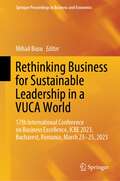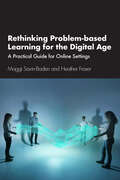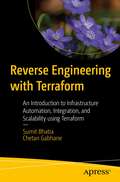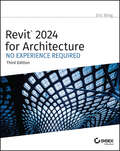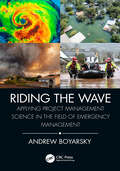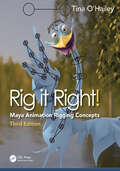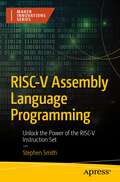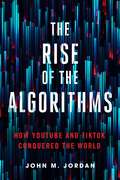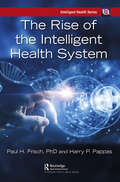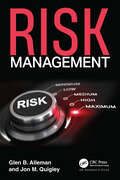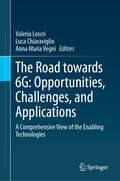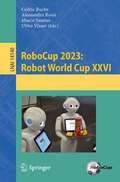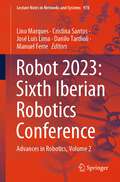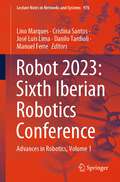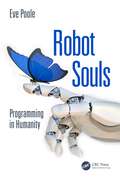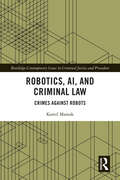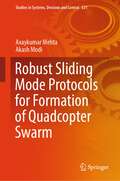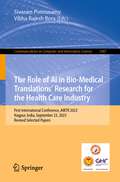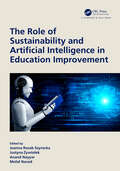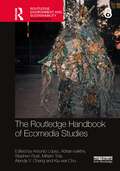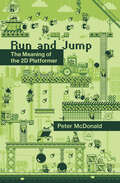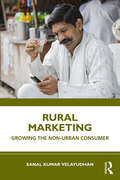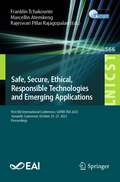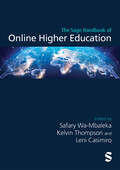- Table View
- List View
Rethinking Business for Sustainable Leadership in a VUCA World: 17th International Conference on Business Excellence, ICBE 2023, Bucharest, Romania, March 23-25, 2023 (Springer Proceedings in Business and Economics)
by Mihail BusuThis book presents a selection of the best papers from the 17th International Conference on Business Excellence, “Rethinking Business: Sustainable Leadership in a VUCA World” (ICBE 2023), held in Bucharest, Romania, in March 2023.In today's rapidly evolving landscape, characterized by volatility, uncertainty, complexity, and ambiguity (VUCA), the need to reshape business practices has become paramount. The book showcases research findings and perspectives on the new challenges particularly posed by the digital economy and research systems. Focusing on revolving business and developing sustainable leadership, it offers valuable insights into the present context of global crisis, together with solutions for the real-world challenges we face today.
Rethinking Problem-based Learning for the Digital Age: A Practical Guide for Online Settings
by Maggi Savin-Baden Heather FraserRethinking Problem-based Learning for the Digital Age provides grounded, evidence-based strategies for teaching faculty, academic developers and educational technologists who are changing their problem-based learning (PBL) modules and programmes from face-to-face to online. Given today’s rapid advancements in learning and curriculum development specific to online and blended modes, there is considerable potential to introduce new forms of PBL in higher education. This book applies fundamental and cutting-edge research, including original scholarship by the authors, to innovative PBL practices and realistic tasks that can be brought to life through digital environments, teamwork and resources. Whether re-contextualizing PBL practices for newly online/blended instruction or seeking fresh PBL approaches for existing digital education environments across disciplines, readers will be guided to construct active, highly motivating, learner-centred experiences using simulations, games, virtual reality, multimedia and other complex innovations.
Reverse Engineering with Terraform: An Introduction to Infrastructure Automation, Integration, and Scalability using Terraform
by Sumit Bhatia Chetan GabhaneThis book is a comprehensive guide for employing Terraform in infrastructure as code automation, and its application to infrastructure operations. Reverse Engineering with Terraform begins with an introduction to Terraform’s core functionalities, including state files, configuration files, and providers, followed by a deep dive into the tool. You’ll then learn how to pinpoint problems with Terraform automation and how reverse engineering can help you resolve them. Drilling down, authors Sumit Bhatia and Chetan Gabhane walk you through the various steps in reverse engineering with an eye towards more effective Terraform integration with preexisting and legacy IT infrastructure. Using a real-world reverse engineering example, they demonstrate how to import a preexisting resource into your infrastructure, which can help you develop an automatable and scalable method for Terrraform adoption. You’ll also learn how to create reusable, shareable components to streamline infrastructure code and foster collaboration within teams, and advanced techniques for using Terraform to optimize infrastructure provisioning, configuration, and management. Filled with real-world case studies, tips and tricks, and best practices, this book will leave you with a thorough understanding of the infrastructure as code paradigm, and how to leverage Terraform automation with legacy as well as modern IT infrastructure. What You Will Learn Understand Terraform and its infrastructure automation capabilities Explore how Terraform can be used with other platforms like AWS, Azure and VMware Master the basic concepts of reverse engineering for legacy infrastructure entities Enable Terraform in legacy IT environments through reverse engineering Who This Book Is For IT architects, admins, technical managers, and infrastructure solution experts. Minimal knowledge of Python programming is the only prerequisite.
Revit 2024 for Architecture: No Experience Required
by Eric WingThe latest and most authoritative version of the popular step-by-step tutorial for Revit Architecture The newly revised third edition of Revit 2024 for Architecture: No Experience Required is the latest update to the market-leading, real-world guide for learning and building with Revit—the powerful and sophisticated Building Information Modeling (BIM) software used by professionals around the world. This popular, user-friendly book teaches you the Revit interface and helps you understand the foundational concepts and features of the software. You’ll learn to design, document, and present a 3D BIM project with a continuous, step-by-step tutorial that guides you through every phase of the project: from placing walls, doors, windows, structural elements, dimensions, and text, to generating documentation, advanced detailing, site grading, construction scheduling, material takeoffs, and more. In addition, this book helps you prepare for the Autodesk Revit Architecture Certification Exam. Throughout the book, you will find helpful insights directly related to the exam. The last two chapters are dedicated entirely to the exam with a practice test at the end of the book. You’ll also: Learn each phase of designing, documenting, and presenting a four-story office building using a simple yet engaging continuous tutorial Follow the tutorial sequentially or jump to any chapter by downloading the project files from the Sybex website Use the start-to-finish tutorial project as a reference for your own real-world projects and to develop a powerful Revit skillset Gain thorough knowledge of Revit’s essential concepts and features to make the move from 2D drafting to 3D building information modeling Get up to speed with advanced features, including new coverage of advanced walls, families, sites, topography, and moreThe Autodesk Revit 2024 for Architecture: No Experience Required, 3rd Edition, is the go-to guide for professionals and students seeking to learn Revit’s essential functions quickly and effectively.
Riding the Wave: Applying Project Management Science in the Field of Emergency Management (ISSN)
by Andrew BoyarskyEmergency managers and public safety professionals are more frequently being called on to address increasingly challenging and complex critical incidents, with a wider variety and intensity of hazards, threats, and community vulnerabilities. Much of the work that falls into the scope of emergency managers – prevention, preparedness, mitigation – is “blue sky planning” and can be contained and effectively managed within projects. This book provides a foundational project management methodology relevant to emergency management practice, and explains and demonstrates how project management can be applied in the context of emergency and public safety organizations.Special features include: an initial focus on risk assessment and identification of mitigation and response planning measures; a clear set of better practices, using a diverse set of examples relevant to today’s emergency environment, from projects to develop emergency response exercises to application development to hazard mitigation; a framework for managing projects at a strategic level and how to incorporate this into an organization’s program, and presents how to develop and manage an emergency program and project portfolio; and suitability as both a hands-on training guide for emergency management programs and a textbook for academic emergency management programs. This book is intended for emergency managers and public safety professionals who are responsible for developing emergency programs and plans, including training courses, job aids, computer applications and new technology, developing exercises, and for implementing these plans and components in response to an emergency event. This audience includes managers in emergency and first response functions such as fire protection, law enforcement and public safety, emergency medical services, public health and healthcare, sanitation, public works, business continuity managers, crisis managers, and all managers in emergency support functions as described by FEMA. This would include those who have responsibility for emergency management functions, even without the related title.
Rig it Right!: Maya Animation Rigging Concepts
by Tina O'HaileyRig It Right! breaks down rigging so that you can achieve a fundamental understanding of the concept. The author will get you up and rigging with step-by-step tutorials covering multiple animation control types, connection methods, interactive skinning, BlendShapes, edgeloops, and joint placement, to name a few. The concept of a biped is explored as a human compared to a bird character allowing you to see that a biped is a biped and how to problem solve for the limbs at hand. Rig It Right! will take you to a more advanced level where you will learn how to create stretchy rigs with invisible control systems and use that to create your own types of rigs.This highly anticipated Third Edition features updated chapters and images, including new chapters on modeling with proper edgeloop (Rule #1!), how to Rig It Right then Rig it Fast with parallel processing, and new helpful scripts for evaluating your rig with the profiler tools.Key Features Hone your skills every step of the way with short tutorials and editable rigs that accompany each chapter (17+ rigs!!) Read "Tina’s 10 Rules of Rigging" and build the foundational knowledge needed to successfully rig your characters New content: Edgeloops for Good Deformation and Rigging for a Parallel World New scripts for evaluating your rigs’ performance Access the Support Materials and expand your newfound knowledge with editable rigs, exercises, and videos that elaborate on techniques covered in the book
RISC-V Assembly Language Programming: Unlock the Power of the RISC-V Instruction Set (Maker Innovations Series)
by Stephen SmithGain the skills required to dive into the fundamentals of the RISC-V instruction set architecture. This book explains the basics of code optimization, as well as how to interoperate with C and Python code, thus providing the starting points for your own projects as you develop a working knowledge of assembly language for various RISC-V processors.The RISC-V processor is the new open-source CPU that is quickly gaining popularity and this book serves as an introduction to assembly language programming for the processor in either 32- or 64-bit mode. You’ll see how to write assembly language programs for several single board computers, including the Starfive Visionfive 2 and the Espressif ESP32-C3 32-bit RISC-V microcontroller. The book also covers running RISC-V Linux with the QEMU emulator on and Intel/AMD based PC or laptop and all the tools required to do so.Moving on, you’ll examine the basics of the RISC-V hardware architecture, all the groups of RISC-V assembly language instructions and understand how data is stored in the computer’s memory. In addition, you’ll learn how to interface to hardware such as GPIO ports. With RISC-V Assembly Language Programming you’ll develop enough background to use the official RISC-V reference documentation for your own projects.What You'll LearnProgram basic RISC-V Assembly LanguageSee how data is represented and stored in a RISC-V based computerMake operating system calls from Assembly Language and include other software libraries in projectsInterface to various hardware devicesComprehend code containing Assembly LanguageReverse engineer and hack codeUse the official RISC-V reference documentationWho This Book Is ForThose who have already learned to program in a higher-level language like Python, Java, C# or even C and now wish to learn Assembly Language programming.
The Rise of the Algorithms: How YouTube and TikTok Conquered the World
by John M. JordanThe meteoric rise of online video is reshaping the competition for human attention. The Rise of the Algorithms argues that this new technology has changed the way we interact with others, our relationships with public institutions, and our very own behaviors and psyches. In tracing the origins and evolution of online video, John M. Jordan examines the mechanics—and the ethical stakes—of online video platforms, especially YouTube and TikTok but also others, such as Twitch. Tracing the use of algorithms pioneered by Facebook and Google and so successfully exploited by TikTok’s corporate parent, ByteDance, Jordan shows how these platforms now engineer human behavior—with consequences for culture, politics, and identity. Jordan argues that we are at an inflection point. Until now we have proved, as a society, ill-prepared or unwilling to address such problems as the power of digital platforms, the personal cost of viral celebrity, the invasion of privacy, and the proliferation of disinformation. The Rise of the Algorithms combines this urgent assessment with a clear-eyed discussion of present challenges and recommendations for reclaiming our online futures.A valuable resource for understanding the transformations that have been and will be brought by YouTube, TikTok, and similar platforms, Jordan’s timely book is a vital work for anyone who uses the internet and especially for policy makers, technologists, communication and media specialists, and researchers who have a direct hand in determining the future of our online world.
The Rise of the Intelligent Health System (Intelligent Health Series)
by Paul H. Frisch Harry P. Pappas"I recommend that all members of the health community read this book to obtain a real snapshot of how the Intelligent Health System is being transformed via new technologies." Chris Landon MD FAAP, FCCP, FRSM Clinical Associate Professor USC Keck School of Medicine Technology Development Center Laboratory and Studio The "Intelligent Health Pavilion" as demonstrated at the annual HIMSS Conference by the Intelligent Health Association is the impetus for this book. This book documents the remarkable journey of "Intelligent Health System" and the adoption of Innovative technologies. Many showcased in real time on the trade show floor and now in this book: "The Rise of the Intelligent Health System". In each chapter of this book, authors are expressing the immense potential of merging cutting-edge technology with the complex realm of patient care and safety. The informative chapters in this book delve deep into the unfolding story of how hospitals have evolved into interactive, intelligent environments, driven by real-time data and powered by artificial intelligence. In what seems like the blink of an eye, technology has completely transformed the way we live, work, and interact with the world around us. From smartphones to self-driving cars, ChatGPT, wireless technologies, wearables, and many other innovations are reshaping our society, pushing the boundaries of what was once considered impossible. However, nowhere is the impact of technology more profound than in the field of healthcare.
Risk Management
by Glen B. Alleman Jon M. QuigleyProject success is an elusive goal in every business or technical domain. Project failure usually results from unhandled risks to the technical, cost, and schedule aspects of the project. There are four primary root causes of project failure. Unrealistic performance expectation, with missing Measures of Effectiveness Unrealistic cost and schedule estimates based on inadequate risk adjusted growth models Inadequate assessment of risk and unmitigated exposure to these risks without proper handling strategies Unanticipated technical issues with alternative plans and solutions to maintain the effectiveness of the project processes and its deliverables Risk Management provides a comprehensive overview of the people, principles, processes, and practices as the fundamental base upon which an effective risk management system resides. However, this does not guarantee effective risk management and successful projects and businesses. The first half of the book describes risk management processes, as well as a delineation between risk and hazards and how these are connected. The second half of the book provides industry examples of the approach to risk management in specific context and with specific approaches and artifacts where applicable.The book focuses on risks created by uncertainty, their identification, and the corrective and preventive actions needed to address these risks to increase the probability of project success. The book’s goal is to provide a context-driven framework, developing a foundation for a rational approach to risk management that makes adaptation to circumstances as easy as possible.
The Road towards 6G: A Comprehensive View of the Enabling Technologies
by Valeria Loscri Luca Chiaraviglio Anna Maria VegniThe proposed book will provide a comprehensive picture of the journey from 5G networks towards 6G. Different aspects, ranging from theoretical foundations to existing platforms and technologies will be presented and analysed, by critically highlighting the real opportunities and the challenges. The first chapters are to describe the general “transitioning” aspects from 5G to 6G. After that, an overview on the different technologies is provided, to present at the end the security aspects, the new applications and an analysis of the electromagnetic exposure, above all in terms of comparative in respect of 5G. Security and Application will be straightforward better explained after the big picture on the different technologies is detailed in the previous chapters. 6G is an emerging complex paradigm, with some important new concepts, that would enable an extremely high reliability and low latency. The main purpose is to provide the reader a thorough vision of the enabling technologies, their potential and what is still needed to fill the gap in terms of sustainability and coexistence of the different technologies. Since different emerging technologies will be considered and detailed in the book, it will be interesting for the reader to infer the major opportunities of each and the main limitations. This kind of information will mainly boost the potential interactions of different technologies to provide a more reliable system.
RoboCup 2023: Robot World Cup XXVI (Lecture Notes in Computer Science #14140)
by Cédric Buche Alessandra Rossi Marco Simões Ubbo VisserThis book constitutes the proceedings of the 26th RoboCup International Symposium which was held in Bordeaux, France, during July 4-10, 2023. The 25 regular papers included in these proceedings were carefully reviewed and selected from 47 submissions; the volume also includes 11 RoboCup Champions Papers. In addition to presenting the proceedings of the RoboCup 2023 Symposium, the book highlights the approaches of champion teams from the competitions. Due to the complex research challenges set by the RoboCup initiative, the RoboCup International Symposium offers a unique perspective for exploring scientific and engineering principles underlying advanced robotic and AI systems.
Robot 2023: Advances in Robotics, Volume 2 (Lecture Notes in Networks and Systems #978)
by Lino Marques Cristina Santos José Luís Lima Danilo Tardioli Manuel FerreThis book contains a selection of papers accepted for presentation and discussion at ROBOT2023, the Sixth Iberian Robotics Conference, held in the University of Coimbra, Coimbra, Portugal, during November 22nd-24th, 2023. ROBOT2023 is part of a series of conferences that are jointly organized by Sociedade Portuguesa de Robótica (SPR) / Portuguese Society for Robotics and by Sociedad Española para la Investigación y Desarrollo en Robótica (SEIDROB) / Spanish Society for Research and Development in Robotics. These conferences, now occurring with a yearly periodicity, provide a forum to roboticists mostly from Iberia, but also from other parts of the world, to present and discuss their research results, new developments, and applications in the field of Robotics. The volume 1 of this book contains 45 papers addressing fundamental aspects of mobile robotics and robot manipulation while volume 2 contains 45 papers covering the application of robotics in different domains and environments.
Robot 2023: Advances in Robotics, Volume 1 (Lecture Notes in Networks and Systems #976)
by Lino Marques Cristina Santos José Luís Lima Danilo Tardioli Manuel FerreThis text will be replaced by the correct backcovertext / informationtext as soon as we get it.
Robot Souls: Programming in Humanity
by Eve PooleTwo of the biggest design problems in Artificial Intelligence are how to build robots that behave in line with human values and how to stop them ever going rogue. One under-explored solution to these alignment and control problems might be to examine how these are already addressed in the design of humans. Looking closely at the human blueprint, it contains a suite of capacities that are so clumsy they have generally been kept away from AI. It was assumed that robots with features like emotions and intuition, that made mistakes and looked for meaning and purpose, would not work as well as robots without this kind of code. But on considering why all these irrational properties are there, it seems that they emerge from the source code of soul. Because it is actually this ‘junk’ code that makes us human and promotes the kind of reciprocal altruism that keeps humanity alive and thriving. Robot Souls looks at developments in AI and reviews the emergence of ideas of consciousness and the soul. It places our ‘junk code’ in this context and argues that it is time to foreground that code, and to use it to look again at how we are programming AI.
Robotics, AI and Criminal Law: Crimes Against Robots (Routledge Contemporary Issues in Criminal Justice and Procedure)
by Kamil MamakThis book offers a phenomenological perspective on the criminal law debate on robots. Today, robots are protected in some form by criminal law. A robot is a person’s property and is protected as property. This book presents the different rationale for protecting robots beyond the property justification based on the phenomenology of human-robot interactions. By focusing on robots that have bodies and act in the physical world in social contexts, the work provides an assessment of the issues that emerge from human interaction with robots, going beyond perspectives focused solely on artificial intelligence (AI). Here, a phenomenological approach does not replace ontological concerns, but complements them. The book addresses the following key areas: Regulation of robots and AI; Ethics of AI and robotics; and philosophy of criminal law. It will be of interest to researchers and academics working in the areas of Criminal Law, Technology and Law and Legal Philosophy.
Robust Sliding Mode Protocols for Formation of Quadcopter Swarm (Studies in Systems, Decision and Control #521)
by Axaykumar Mehta Akash ModiThis book presents several robust sliding mode protocols for achieving the formation and tracking of Quadcopter swarm for a given pattern. In entire book, the concept of leader-follower formation control of a multi-agent system is exploited for deriving the protocols and the graph theory is used to represent the communication between the Quadcopters. The book covers two types of formation protocols of the Quadcopter swarm namely, continuous-time sliding mode protocols and discrete-time sliding mode protocols. First, the continuous-time higher order sliding mode protocols using super-twisting algorithm are designed for formation using linear and non-linear models of Quadcopter. Then, the discrete-time sliding mode protocols using power rate reaching law, discrete-time super twisting algorithm, and exponential reaching law are presented. The protocols are thoroughly analysed for robustness, chattering, control effort, and convergence time for achieving the formation. Also, the stability conditions using the Lyapunov function are derived to ensure the stability of the swarm with each protocol. Further, each chapter includes extensive simulation and comparative studies to show the efficacy of each protocol. The book will be useful to graduate students, research scholars, and professionals working in the domain of civilian and military usage of the drone technology.
The Role of AI in Bio-Medical Translations’ Research for the Health Care Industry: First International Conference, AIBTR 2023, Nagpur, India, September 23, 2023, Revised Selected Papers (Communications in Computer and Information Science #1987)
by Sivaram Ponnusamy Vibha Rajesh BoraThis book constitutes the revised selected papers of the First International Conference, AIBTR 2023, held in Nagpur, India, during September 22–23, 2023.The 7 full papers included in this volume were carefully reviewed and selected from 37 submissions. The papers contained in this book discuss the application of Artificial Intelligence in Biomedical Engineering for the Health Care industry.
The Role of Sustainability and Artificial Intelligence in Education Improvement
by Joanna Rosak-Szyrocka Justyna Żywiołek Anand Nayyar Mohd NavedThis book is devoted to the issues faced by universities in the field of distance learning during and after COVID, as well as in digitalization times. The book devotes a lot of space to the issues of Web 3.0 in university e-learning, Industry 4.0, artificial intelligence and digital equity. The aim and scope of this book is to draw a holistic picture of education before and after COVID, the psychological effects of COVID in education, and using modern technologies application in education, taking into consideration aspects of sustainability development, Industry 4.0 and Society 5.0. The authors also raise the issue of artificial intelligence investigation in learner-instructor interaction. Features: • To elaborate the functions of online education and numerous pedagogical strategies based on electronic learning to aid teachers and students with the tools required to succeed in the 21st century via engaging virtual experiences• To analyze tools provided by Ed-Tech firms and the effect of digital tools on maintaining the educational process in times of crisis and after pandemic• To create a roadmap for higher education institutions and provide tips regarding how to improve the effectiveness of the hybrid learning system• To understand e-learning characteristic in the era of Industry 4.0 and Society 5.0 and characteristics of the different web generations• To use AI applications to improve connections and relationships between students and teachers and in education in the future The book is both scientific and educational. It can be used at the university level and by anyone interested in the topics it covers.
The Routledge Handbook of Ecomedia Studies (Routledge Environment and Sustainability Handbooks)
by Antonio López Adrian Ivakhiv Stephen Rust Miriam Tola Alenda Y. Chang Kiu-Wai ChuThe Routledge Handbook of Ecomedia Studies gathers leading work by critical scholars in this burgeoning field. Redressing the lack of environmental perspectives in the study of media, ecomedia studies asserts that media are in and about the environment, and environments are socially and materially mediated. The book gives form to this new area of study and brings together diverse scholarly contributions to explore and give definition to the field. The Handbook highlights five critical areas of ecomedia scholarship: ecomedia theory, ecomateriality, political ecology, ecocultures, and eco-affects. Within these areas, authors navigate a range of different topics including infrastructures, supply and manufacturing chains, energy, e-waste, labor, ecofeminism, African and Indigenous ecomedia, environmental justice, environmental media governance, ecopolitical satire, and digital ecologies. The result is a holistic volume that provides an in-depth and comprehensive overview of the current state of the field, as well as future developments. This volume will be an essential resource for students, educators, and scholars of media studies, cultural studies, film, environmental communication, political ecology, science and technology studies, and the environmental humanities.
Run and Jump: The Meaning of the 2D Platformer (Playful Thinking)
by Peter D. McDonaldHow abstract design decisions in 2D platform games create rich worlds of meaning for players.Since the 1980s, 2D platform games have captivated their audiences. Whether the player scrambles up the ladders in Donkey Kong or leaps atop an impossibly tall pipe in Super Mario Bros., this deceptively simple visual language has persisted in our cultural imagination of video games. In Run and Jump, Peter McDonald surveys the legacy of 2D platform games and examines how abstract and formal design choices have kept players playing. McDonald argues that there is a rich layer of meaning underneath, say, the quality of an avatar&’s movement, the pacing and rhythm of level design, the personalities expressed by different enemies, and the emotion elicited by collecting a coin.To understand these games, McDonald draws on technical discussions by game designers as well as theoretical work about the nature of signs from structuralist semiotics. Interspersed throughout are design exercises that show how critical interpretation can become a tool for game designers to communicate with their players. With examples drawn from over forty years of game history, and from games made by artists, hobbyists, iconic designers, and industry studios, Run and Jump presents a comprehensive—and engaging—vision of this slice of game history.
Rural Marketing: Growing the Non-urban Consumer
by Sanal Kumar VelayudhanRural markets offer a sizable and resilient pool of consumers to organizations and marketers. This book offers a comprehensive understanding of the fundamentals of rural marketing that influence consumer behaviour within the framework of a rapidly changing economy. The book: - includes in-depth discussions on critical issues in rural markets as well as case-studies that examine their socio-cultural nuances, peculiarities, and their economic and technological environments; - looks at concepts that are unique to rural markets from the perspective of the buyer and the marketer and analyses buying behaviour and its influences as well as the pricing, value, and positioning of products by brands; - analyses emerging trends and the future of these markets and the introduction of digitization and ecommerce in rural areas; - offers marketing tools and a detailed understanding of rural markets for professionals working in small or low-income markets. The cutting-edge learning tools presented in this book will make it of interest to professionals, students, and researchers working in rural marketing and management, business and economics, management studies, business planning, and marketing.
Safe, Secure, Ethical, Responsible Technologies and Emerging Applications: First EAI International Conference, SAFER-TEA 2023, Yaoundé, Cameroon, October 25-27, 2023, Proceedings (Lecture Notes of the Institute for Computer Sciences, Social Informatics and Telecommunications Engineering #566)
by Franklin Tchakounte Marcellin Atemkeng Rajeswari Pillai RajagopalanThis book constitutes the refereed proceedings of the First EAI International Conference on Safe, Secure, Ethical, Responsible Technologies and Emerging Applications, SAFER-TEA 2023, held in Yaoundé, Cameroon, during October 25-27, 2023. The 24 full papers were carefully reviewed and selected from 75 submissions. They were organized in topical sections as follows: Regulations and Ethics of Artificial Intelligence, Resource-constrained Networks and Cybersecurity, Emerging Artificial Intelligence Applications, Reviews.
The Sage Handbook of Online Higher Education
by Safary Wa-Mbaleka Kelvin Thompson Leni CasimiroThe SAGE Handbook of Online Higher Education presents a cutting-edge collection of 50 essays that explores the rapidly evolving landscape of online teaching and learning in higher education. Assembled and contributed by a team of leading experts, the Handbook adopts a uniquely holistic approach to examining the needs of online education. Chapters bring together voices from diverse and international backgrounds to provide insights applicable to a broad range of contexts, and present practical strategies for planning, delivering quality online higher education. The handbook covers a wide range of topics, including online pedagogy, instructional design, student engagement, technological innovation, assessment, leadership, and the developing role of online education in the context of broader societal and cultural shifts. The SAGE Handbook of Online Higher Education is an essential resource for educators, researchers, policymakers, and practitioners who seek to understand and shape the future of higher education in the digital age. Section 1: Fundamentals of Online Education Section 2: Online Education Around the World Section 3: Online Instructional Design Section 4: Online Instructional Delivery Section 5: Instructional Technology for Online Education Section 6: Online Education Administration and Management Section 7: Student Support Services
The Sage Handbook of Online Higher Education
by Safary Wa-Mbaleka Kelvin Thompson Leni CasimiroThe SAGE Handbook of Online Higher Education presents a cutting-edge collection of 50 essays that explores the rapidly evolving landscape of online teaching and learning in higher education. Assembled and contributed by a team of leading experts, the Handbook adopts a uniquely holistic approach to examining the needs of online education. Chapters bring together voices from diverse and international backgrounds to provide insights applicable to a broad range of contexts, and present practical strategies for planning, delivering quality online higher education. The handbook covers a wide range of topics, including online pedagogy, instructional design, student engagement, technological innovation, assessment, leadership, and the developing role of online education in the context of broader societal and cultural shifts. The SAGE Handbook of Online Higher Education is an essential resource for educators, researchers, policymakers, and practitioners who seek to understand and shape the future of higher education in the digital age. Section 1: Fundamentals of Online Education Section 2: Online Education Around the World Section 3: Online Instructional Design Section 4: Online Instructional Delivery Section 5: Instructional Technology for Online Education Section 6: Online Education Administration and Management Section 7: Student Support Services
